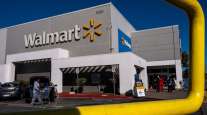Walmart to Build More Robot-Filled Warehouses at Stores

[Stay on top of transportation news: Get TTNews in your inbox.]
NEW YORK — Walmart is enlisting the help of robots to keep up with a surge in online orders.
The company said Jan. 27 that it plans to build warehouses at its stores where self-driving robots will fetch groceries and have them ready for shoppers to pick up in an hour or less.
Walmart declined to say how many of the warehouses it will build, but construction has started at stores in Lewisville, Texas; Plano, Texas; American Fork, Utah; and Bentonville, Ark., where Walmart’s corporate offices are based. A test site was opened more than a year ago at a store in Salem, N.H.
Walmart hopes the warehouses will speed up curbside pickups, where orders are brought outside to shoppers’ cars. The option, along with deliveries, became increasingly popular as virus-weary shoppers avoid going inside stores. At the start of the pandemic last year, Walmart said delivery and pickup sales grew 300%.

Sustainable trucking is here. In this episode, we'll talk to two major players in the transportation technology sector that are helping fleets move closer to total supply chain sustainability. Hear a snippet, above, and get the full program by going to RoadSigns.TTNews.com.
The company said the robots won’t roam store aisles. Instead, they’ll stay inside warehouses built in separate areas, either within a store or next to it. Windows will be placed at some locations so shoppers can watch the robots work.
The wheeled robots carry crates of apple juice, cereal and other small goods to Walmart workers, who then bag them for shoppers. Rival Amazon uses similar technology in its warehouses, with robots bringing books, vitamins and other small items to workers to box and ship.
Walmart said the robots save time since employees don’t have to walk store aisles to find items. Workers will, however, have to go into the store to pick out fresh groceries, such as meat, fish and vegetables. They’ll also have to grab TVs, vacuum cleaners and other items that are too large for the robots to carry.
Want more news? Listen to today's daily briefing:
Subscribe: Apple Podcasts | Spotify | Amazon Alexa | Google Assistant | More




